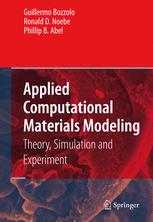

Most ebook files are in PDF format, so you can easily read them using various software such as Foxit Reader or directly on the Google Chrome browser.
Some ebook files are released by publishers in other formats such as .awz, .mobi, .epub, .fb2, etc. You may need to install specific software to read these formats on mobile/PC, such as Calibre.
Please read the tutorial at this link: https://ebookbell.com/faq
We offer FREE conversion to the popular formats you request; however, this may take some time. Therefore, right after payment, please email us, and we will try to provide the service as quickly as possible.
For some exceptional file formats or broken links (if any), please refrain from opening any disputes. Instead, email us first, and we will try to assist within a maximum of 6 hours.
EbookBell Team

0.0
0 reviewsApplied Computational Modeling identifies and emphasizes the successful link between computational materials modeling as a simulation and design tool and its synergistic application to experimental research and alloy development. Compared to other areas in science where computational modeling has made substantial contributions to the development and growth of a particular field, computational materials modeling has been rather limited in its ability to insert itself as a major tool in materials design. The impression that computational modeling is simply an intellectual pursuit with limited real life application has delayed its widespread use by the mainstream materials community, but as in any emerging field, the time has come where it is now difficult to imagine any vigorous materials development program without a strong foundation in modeling.
Hence, this book provides the average person working in the materials field with a more balanced perspective of the role that computational modeling can play in every day research and development efforts. This is done by presenting a series of examples of the successful application of various computational modeling procedures (everything from first principles to quantum approximate to CALPHAD methods) to real life surface and bulk alloy problems.
This book should have a large appeal in the materials community, both for experimentalists who would greatly benefit from adding computational methods to their everyday research regimes, as well as for those scientists/engineers familiar with a particular computational method who would like to add complementary techniques to their arsenal of research and development tools.